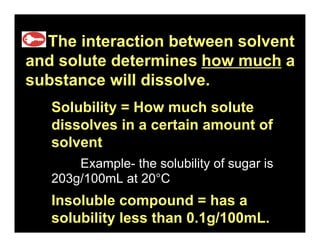
Lecture 16.1- Solubility Factors
- 1. 16.1 The interaction between solvent and solute determines how much a substance will dissolve. Solubility = How much solute dissolves in a certain amount of solvent Example- the solubility of sugar is 203g/100mL at 20°C Insoluble compound = has a solubility less than 0.1g/100mL.
- 2. 16.1 Temperature also determines how much a substance will dissolve.
- 3. 16.1 A saturated solution contains the maximum amount of solute for a given quantity of solvent at a given temperature and pressure. An unsaturated solution contains less solute than a saturated solution.
- 4. 16.1 In a saturated solution, the rate of dissolving equals the rate of crystallization, so the total amount of dissolved solute remains constant.
- 5. 16.1 Some liquids combine in all proportions, while others don’t mix at all. –Two liquids are miscible if they dissolve in each other in all proportions. –Two liquids are immiscible if they are insoluble in each other.
- 6. 16.1 Oil and water are immiscible.
- 7. 16.1 Vinegar and oil are immiscible.
- 8. 16.1 Temperature affects the solubility of anything. Pressure affects the solubility of a gas.
- 9. 16.1 Temperature –The solubility of a solid increases as the temperature of the solvent increases. –The solubility of a gas decreases as temperature increases.
- 10. 16.1 The mineral deposits around hot springs result from the cooling of the hot, saturated solution of minerals emerging from the spring.
- 11. 16.1
- 12. 16.1 A supersaturated solution contains more solute than it can theoretically hold at a given temperature. Crystallization of the extra solute can be initiated if a very small crystal of the solute is added.
- 13. 16.1 A supersaturated solution is clear before a seed crystal is added.
- 14. 16.1 Crystals begin to form in the solution immediately after the addition of a seed crystal.
- 15. 16.1 Excess solute crystallizes rapidly.
- 16. 16.1
- 17. 16.1 Pressure Changes in pressure have little effect on the solubility of solids and liquids. Gas solubility increases as the partial pressure of the gas above the solution increases.
- 18. 16.1 Honors only Henry’s law states that at a given temperature, the solubility (S) of a gas in a liquid is directly proportional to the pressure (P) of the gas above the liquid.
- 24. The factors that determine how fast a substance dissolves are •stirring (agitation) •Temperature (also affects how much dissolves) •the surface area of the dissolving particles
- 25. 16.1 A cube of sugar in cold tea dissolves slowly.
- 26. 16.1 Granulated sugar dissolves in cold water more quickly than a sugar cube, especially with stirring.
- 27. 16.1 Granulated sugar dissolves very quickly in hot tea.
- 28. At higher temperatures molecules move faster. Water molecules surround and remove the solute particles from the solid more quickly.
- 29. 16.1 Particle Size and Solution Formation A spoonful of granulated sugar dissolves more quickly than a sugar cube because the smaller particles in granulated sugar expose a much greater surface area to the colliding water molecules.
- 30. 16.1 Stirring and Solution Formation Stirring speeds up the dissolving process because fresh solvent (the water in tea) is continually brought into contact with the surface of the solute (sugar).
- 31. 16.1 Section Quiz. 1. For a given substance, which of the following will NOT influence how fast it dissolves? a. temperature b. amount of agitation c. molar mass d. size of the crystals
- 32. 16.1 Section Quiz. 3. The solubility of a gas in a solvent is affected by a. both temperature and pressure. b. only pressure. c. only temperature. d. both pressure and agitation.